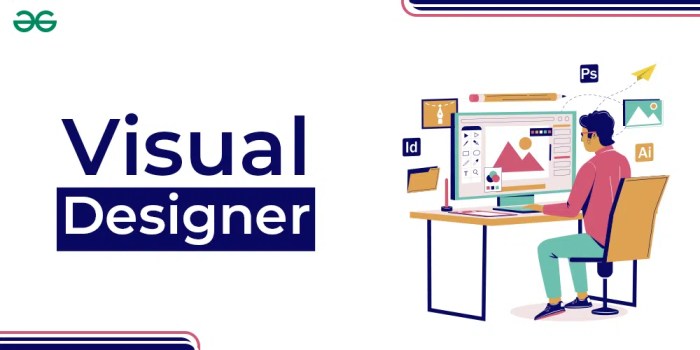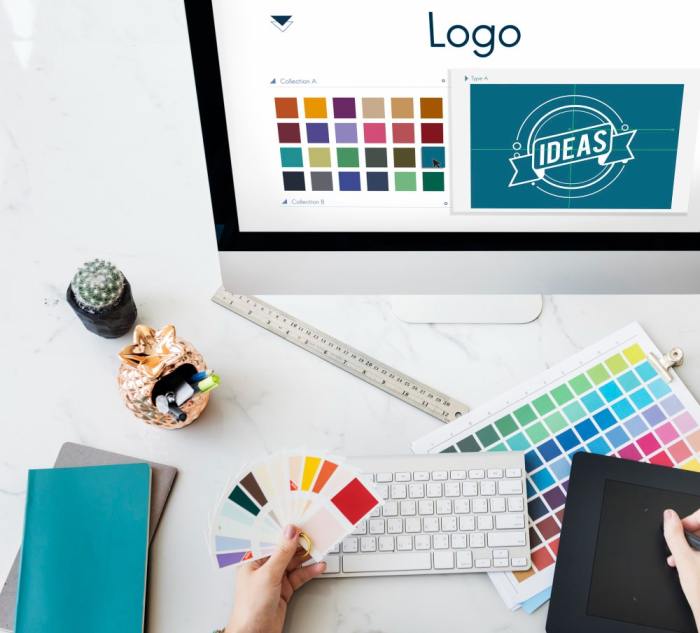Crafting Compelling Visual Designs: A Comprehensive Guide
Visual design is a crucial aspect that influences how we interact with the world around us. From websites to advertisements, visual design plays a significant role in captivating our attention and conveying messages effectively. In this guide, we will delve into the intricacies of visual design, exploring its principles, elements, tools, trends, and more.
Get ready to embark on a journey that unveils the art and science behind visually appealing creations.
Introduction to Visual Design
Visual design is the practice of creating visual content to communicate messages or information effectively. It plays a crucial role in various industries such as marketing, web design, branding, and user interface design. Visual design involves the use of elements like color, typography, layout, and imagery to create visually appealing and engaging experiences for users.
Importance of Visual Design
Visual design is essential in capturing the attention of the audience and conveying the intended message clearly. It helps in establishing brand identity, enhancing user interaction, and increasing the overall usability of a product or service.
- Color: The choice of colors can evoke specific emotions or associations, affecting how users perceive a design.
- Typography: Different font styles and sizes can influence readability and create hierarchy within the content.
- Layout: The arrangement of elements on a page can guide the user's eye flow and improve the overall user experience.
- Imagery: Visual elements like photos, illustrations, and icons can enhance the aesthetic appeal of a design and make it more engaging.
Principles of Visual Design

Visual design is guided by several fundamental principles that help create aesthetically pleasing and functional designs. These principles include balance, contrast, alignment, and proximity. Each of these principles plays a crucial role in determining the overall look and feel of a design.
Balance
Balance in visual design refers to the distribution of elements within a design to create a sense of equilibrium. There are two types of balance: symmetrical and asymmetrical. Symmetrical balance involves arranging elements equally on both sides of a central axis, creating a sense of stability and formality.
On the other hand, asymmetrical balance involves distributing elements unequally but still achieving a sense of balance through contrast and color.
Contrast
Contrast is the difference between elements in a design, such as color, size, or shape. By using contrast, designers can create visual interest and hierarchy within a design. This principle helps guide the viewer's eyes to important elements and creates a dynamic and engaging composition.
Alignment
Alignment in visual design refers to the arrangement of elements along a common axis. Proper alignment helps create a sense of order and organization within a design. Whether elements are aligned to a grid or to each other, alignment ensures that the design looks cohesive and visually appealing.
Proximity
Proximity refers to the relationship between elements in a design. Elements that are closer together are perceived as related, while those that are further apart are seen as separate. By using proximity, designers can group related elements together and create a clear visual hierarchy within a design.
Application of Design Principles
Each design medium, whether print, digital, or product design, may prioritize different design principles based on its specific requirements. For example, print design may focus more on balance and alignment to ensure readability and aesthetic appeal, while digital design may emphasize contrast and proximity to guide user interaction and engagement.
Product design, on the other hand, may prioritize alignment and contrast to enhance usability and functionality.
Elements of Visual Design
Visual design encompasses various key elements that play a crucial role in creating visually appealing and effective designs. These elements include color theory, typography, space, and texture. Each element contributes uniquely to the overall visual appeal and communication of a design, making them essential components in the creation of cohesive and impactful designs.
Color Theory
Color theory is fundamental in visual design as it helps designers understand the psychological impact of different colors and how they interact with one another. By utilizing the principles of color theory, designers can evoke specific emotions, create visual hierarchy, and establish a cohesive color scheme that enhances the overall design.
For example, warm colors like red and yellow can convey energy and passion, while cool colors like blue and green evoke a sense of calmness and tranquility.
Typography
Typography refers to the style and arrangement of text in a design. Choosing the right fonts, sizes, spacing, and alignment can significantly impact the readability, mood, and tone of a design. Typography plays a crucial role in establishing hierarchy, guiding the viewer's eye, and conveying the intended message.
For instance, a bold and sans-serif font may be used for headings to grab attention, while a clean and legible serif font may be more suitable for body text to enhance readability.
Space
Space, also known as negative space, is the area around and between elements in a design. Proper use of space helps create balance, emphasis, and visual clarity in a design. By strategically utilizing space, designers can direct the viewer's focus, establish relationships between elements, and enhance the overall aesthetic appeal of the design.
For example, ample white space can create a sense of elegance and sophistication, while tight spacing can convey a sense of density and urgency.
Texture
Texture adds depth and tactile quality to a design, making it more visually engaging and stimulating. Whether through actual tactile textures or visual textures created through patterns and gradients, texture can evoke emotions, create visual interest, and enhance the overall sensory experience of a design.
For instance, a rough texture may convey a sense of ruggedness or authenticity, while a smooth texture can evoke a feeling of luxury or refinement.
Tools and Software for Visual Design

Visual designers rely on a variety of tools and software to bring their creative ideas to life. Here are some popular options used in the industry along with tips for maximizing their potential.
Adobe Creative Suite
Adobe Creative Suite is a powerhouse software package that includes Photoshop, Illustrator, InDesign, and more. Each program offers unique features for editing photos, creating illustrations, and designing layouts. Tips for using Adobe Creative Suite effectively include mastering keyboard shortcuts, utilizing layers for organization, and exploring online tutorials to expand your skillset.
Sketch
Sketch is a vector-based design tool favored by many UI/UX designers for its ease of use and robust features. It allows for the creation of responsive designs and prototypes, making it ideal for web and app design projects. To make the most of Sketch, take advantage of its reusable symbols, artboards for different screen sizes, and plugins for added functionality.
Figma
Figma is a cloud-based design tool that enables real-time collaboration among team members, making it perfect for remote work environments. It offers features for creating interactive prototypes, user interface design, and design systems. To optimize your workflow in Figma, utilize components for consistency, explore the auto-layout feature for responsive design, and leverage plugins to extend its capabilities.
Canva
Canva is a user-friendly graphic design platform that caters to both beginners and professionals. It provides a wide range of templates for social media graphics, presentations, posters, and more. When using Canva, customize templates to suit your branding, experiment with different fonts and colors, and explore the vast library of stock images and illustrations to enhance your designs.
Trends in Visual Design
Visual design trends are constantly evolving, shaping the way we perceive and interact with various forms of media. Let's delve into some of the current trends that are making waves in the design industry.
Minimalism
Minimalism continues to be a dominant trend in visual design, characterized by clean lines, ample white space, and simplicity. This design approach focuses on stripping away unnecessary elements to convey a message effectively and efficiently.
Bold Colors
Using bold and vibrant colors in visual design has become increasingly popular. Bright hues can evoke strong emotions and create a memorable visual impact. Designers are embracing color psychology to communicate brand identity and engage audiences.
Gradients
Gradients have made a comeback in visual design, adding depth and dimension to digital interfaces. From subtle color transitions to bold duotones, gradients can enhance visual storytelling and create visually compelling designs that capture attention.
3D Elements
The integration of 3D elements in visual design has opened up new possibilities for creating immersive and interactive experiences. From 3D typography to product visualizations, designers are leveraging advanced technology to push the boundaries of design innovation.
Influence on Different Industries
These trends are not limited to a specific industry but are influencing design across various sectors. From digital marketing and e-commerce to fashion and architecture, visual design trends are shaping the way brands communicate with their audiences and differentiate themselves in a competitive market.
Future Directions
As emerging technologies like augmented reality (AR) and virtual reality (VR) continue to evolve, visual design is expected to become even more immersive and interactive. Designers will need to adapt to changing consumer behaviors and cultural shifts to create engaging and meaningful experiences in a digital world.
Last Recap

As we conclude this exploration of visual design, it becomes evident that the fusion of creativity and strategy is at the core of impactful design. By understanding the principles, mastering the elements, and staying abreast of trends, designers can craft compelling visuals that leave a lasting impression on audiences.
Embrace the power of visual storytelling and let your creativity soar in the realm of visual design.
FAQ Explained
What is the significance of color theory in visual design?
Color theory plays a crucial role in visual design by influencing emotions, creating visual hierarchy, and establishing brand identity.
How do typography choices impact the overall design aesthetic?
Typography choices can convey tone, improve readability, and enhance visual appeal, making them an essential element of design.
Which software is commonly used for visual design?
Popular software includes Adobe Creative Suite, Sketch, Figma, and Canva, each offering unique features for creating stunning visuals.




